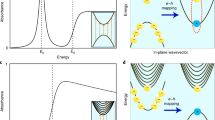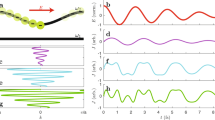Abstract
An intense laser field can remove an electron from an atom or molecule and pull the electron into a large-amplitude oscillation in which it repeatedly collides with the charged core it left behind1,2,3,4. Such recollisions result in the emission of very energetic photons by means of high-order-harmonic generation, which has been observed in atomic and molecular gases5,6,7 as well as in a bulk crystal8. An exciton is an atom-like excitation of a solid in which an electron that is excited from the valence band is bound by the Coulomb interaction to the hole it left behind9,10. It has been predicted that recollisions between electrons and holes in excitons will result in a new phenomenon: high-order-sideband generation11,12. In this process, excitons are created by a weak near-infrared laser of frequency fNIR. An intense laser field at a much lower frequency, fTHz, then removes the electron from the exciton and causes it to recollide with the resulting hole. New emission is predicted to occur as sidebands of frequency fNIR + 2nfTHz, where n is an integer that can be much greater than one. Here we report the observation of high-order-sideband generation in semiconductor quantum wells. Sidebands are observed up to eighteenth order (+18fTHz, or n = 9). The intensity of the high-order sidebands decays only weakly with increasing sideband order, confirming the non-perturbative nature of the effect. Sidebands are strongest for linearly polarized terahertz radiation and vanish when the terahertz radiation is circularly polarized. Beyond their fundamental scientific significance, our results suggest a new mechanism for the ultrafast modulation of light, which has potential applications in terabit-rate optical communications.
This is a preview of subscription content, access via your institution
Access options
Subscribe to this journal
Receive 51 print issues and online access
$199.00 per year
only $3.90 per issue
Buy this article
- Purchase on Springer Link
- Instant access to full article PDF
Prices may be subject to local taxes which are calculated during checkout



Similar content being viewed by others
References
Krause, J. L., Schafer, K. J. & Kulander, K. C. High-order harmonic generation from atoms and ions in the high intensity regime. Phys. Rev. Lett. 68, 3535–3538 (1992)
Corkum, P. B. Plasma perspective on strong field multiphoton ionization. Phys. Rev. Lett. 71, 1994–1997 (1993)
Lewenstein, M., Balcou, P., Ivanov, M. Y., L’Huillier, A. & Corkum, P. B. Theory of high-harmonic generation by low-frequency laser fields. Phys. Rev. A 49, 2117–2132 (1994)
Corkum, P. B. Recollision physics. Phys. Today 64, 36–41 (2011)
Ferray, M. et al. Multiple-harmonic conversion of 1064 nm radiation in rare gases. J. Phys. B 21, L31–L35 (1988)
Liang, Y., Augst, S., Chin, S. L., Beaudoin, Y. & Chaker, M. High harmonic generation in atomic and diatomic molecular gases using intense picosecond laser pulses-a comparison. J. Phys. B 27, 5119–5130 (1994)
Krausz, F. & Ivanov, M. Attosecond physics. Rev. Mod. Phys. 81, 163–234 (2009)
Ghimire, S. et al. Observation of high-order harmonic generation in a bulk crystal. Nature Phys. 7, 138–141 (2011)
Wannier, G. H. The structure of electronic excitation levels in insulating crystals. Phys. Rev. 52, 191–197 (1937)
Dingle, R., Wiegmann, W. & Henry, C. H. Quantum states of confined carriers in very thin AlxGa1-xAs-GaAs-AlxGa1-xAs heterostructures. Phys. Rev. Lett. 33, 827–830 (1974)
Liu, R.-B. & Zhu, B.-F. High-order THz-sideband generation in semiconductors. AIP Conf. Proc. 893, 1455–1456 (2007)
Yan, J.-Y. Theory of excitonic high-order sideband generation in semiconductors under a strong terahertz field. Phys. Rev. B 78, 075204 (2008)
Corkum, P. B. & Krausz, F. Attosecond science. Nature Phys. 3, 381–387 (2007)
Keldysh, L. V. Ionization in the field of a strong electromagnetic wave. Sov. Phys. JETP 20, 1307–1314 (1965)
Uiberacker, M. et al. Attosecond real-time observation of electron tunnelling in atoms. Nature 446, 627–632 (2007)
Wagner, M. et al. Resonant enhancement of second order sideband generation for intraexcitonic transitions in GaAs/AlGaAs multiple quantum wells. Appl. Phys. Lett. 94, 241105 (2009)
Wagner, M. et al. Terahertz nonlinear optics using intra-excitonic quantum well transitions: sideband generation and AC Stark splitting. Phys. Status Solidi 248, 859–862 (2011)
Nordstrom, K. B. et al. Excitonic dynamical Franz-Keldysh effect. Phys. Rev. Lett. 81, 457–460 (1998)
Carter, S. G. et al. Quantum coherence in an optical modulator. Science 310, 651–653 (2005)
Danielson, J. R. et al. Interaction of strong single-cycle terahertz pulses with semiconductor quantum wells. Phys. Rev. Lett. 99, 237401 (2007)
Leinß, S. et al. Terahertz coherent control of optically dark paraexcitons in Cu2O. Phys. Rev. Lett. 101, 246401 (2008)
Wagner, M. et al. Observation of the intraexciton Autler-Townes effect in GaAs/AlGaAs semiconductor quantum wells. Phys. Rev. Lett. 105, 167401 (2010)
Zaks, B. et al. THz-driven quantum wells: Coulomb interactions and Stark shifts in the ultrastrong coupling regime. N. J. Phys. 13, 083009 (2011)
Nordstrom, K. B. et al. Observation of dynamical Franz-Keldysh effect. Phys. Status Solidi 204, 52–54 (1997)
Kono, J. et al. Resonant terahertz optical sideband generation from confined magnetoexcitons. Phys. Rev. Lett. 79, 1758–1761 (1997)
Černe, J. et al. Near-infrared sideband generation induced by intense far-infrared radiation in GaAs quantum wells. Appl. Phys. Lett. 70, 3543–3545 (1997)
Itatani, J. et al. Tomographic imaging of molecular orbitals. Nature 432, 867–871 (2004)
Haessler, S. et al. Attosecond imaging of molecular electronic wavepackets. Nature Phys. 6, 200–206 (2010)
Vozzi, C. et al. Generalized molecular orbital tomography. Nature Phys. 7, 822–826 (2011)
Eisele, H. State of the art and future of electronic sources at terahertz frequencies. Electron. Lett. 46, S8–S11 (2010)
Acknowledgements
Samples are from the wafers grown at UCSB by C. Wang in the group of L. C. Coldren (15-nm quantum well) and by T. Truong in the group of P. M. Petroff (18- and 22-nm quantum wells; see Supplementary Information) for experiments described in refs 19 and 23, respectively. We would like to thank D. Enyeart for his help in running the UCSB FELs and N. H. Kwong for running simulations helpful to our understanding of these effects. This work was supported by NSF grant DMR-1006603 and Hong Kong RGC/GRF 401011.
Author information
Authors and Affiliations
Contributions
B.Z. was responsible for conducting experiments and analysing the data presented, and for writing the paper. R.B.L. introduced M.S.S. to the predictions of HSG, and provided theoretical support. M.S.S. designed and supervised the study and edited the paper. All authors discussed the results and commented on the paper.
Corresponding author
Ethics declarations
Competing interests
The authors declare no competing financial interests.
Supplementary information
Supplementary Information
This file contains Supplementary Methods, a Supplementary Discussion, Supplementary Data, Supplementary Equations, Supplementary Figures 1-5 and additional references. (PDF 858 kb)
Rights and permissions
About this article
Cite this article
Zaks, B., Liu, R. & Sherwin, M. Experimental observation of electron–hole recollisions. Nature 483, 580–583 (2012). https://doi.org/10.1038/nature10864
Received:
Accepted:
Published:
Issue Date:
DOI: https://doi.org/10.1038/nature10864
This article is cited by
-
Floquet engineering of strongly driven excitons in monolayer tungsten disulfide
Nature Physics (2023)
-
Lightwave electronics in condensed matter
Nature Reviews Materials (2023)
-
Build-up and dephasing of Floquet–Bloch bands on subcycle timescales
Nature (2023)
-
Gate-tunable quantum pathways of high harmonic generation in graphene
Nature Communications (2022)
-
Enhanced coherent transition radiation from midinfrared-laser-driven microplasmas
Scientific Reports (2022)
Comments
By submitting a comment you agree to abide by our Terms and Community Guidelines. If you find something abusive or that does not comply with our terms or guidelines please flag it as inappropriate.



